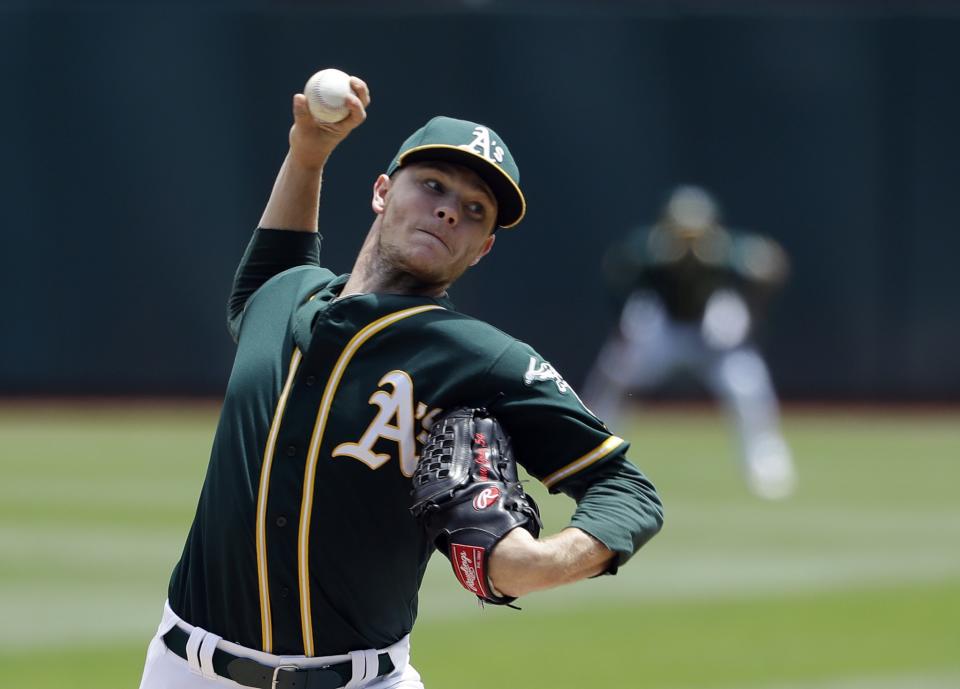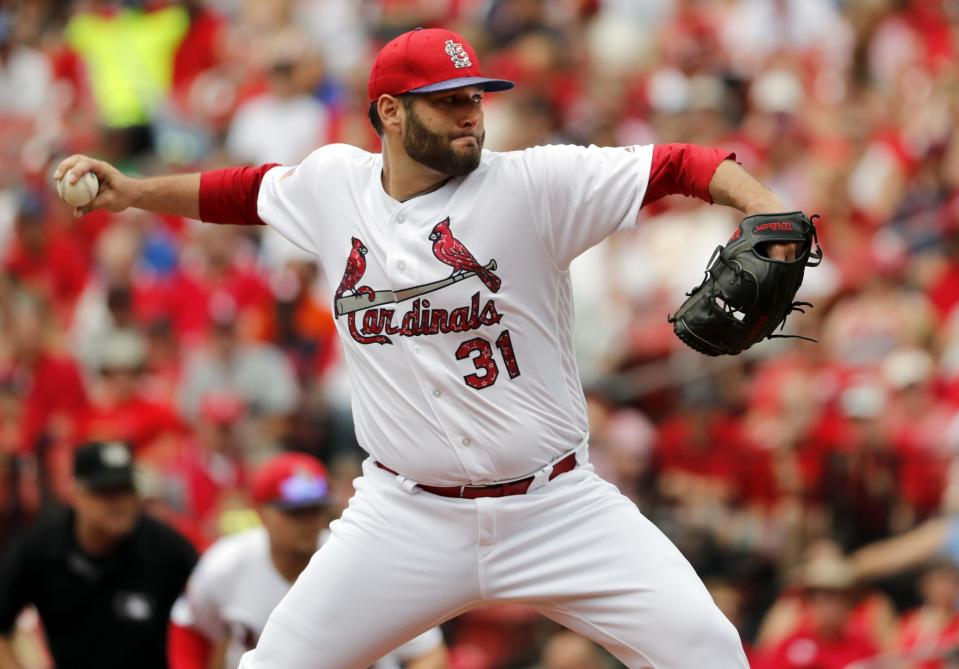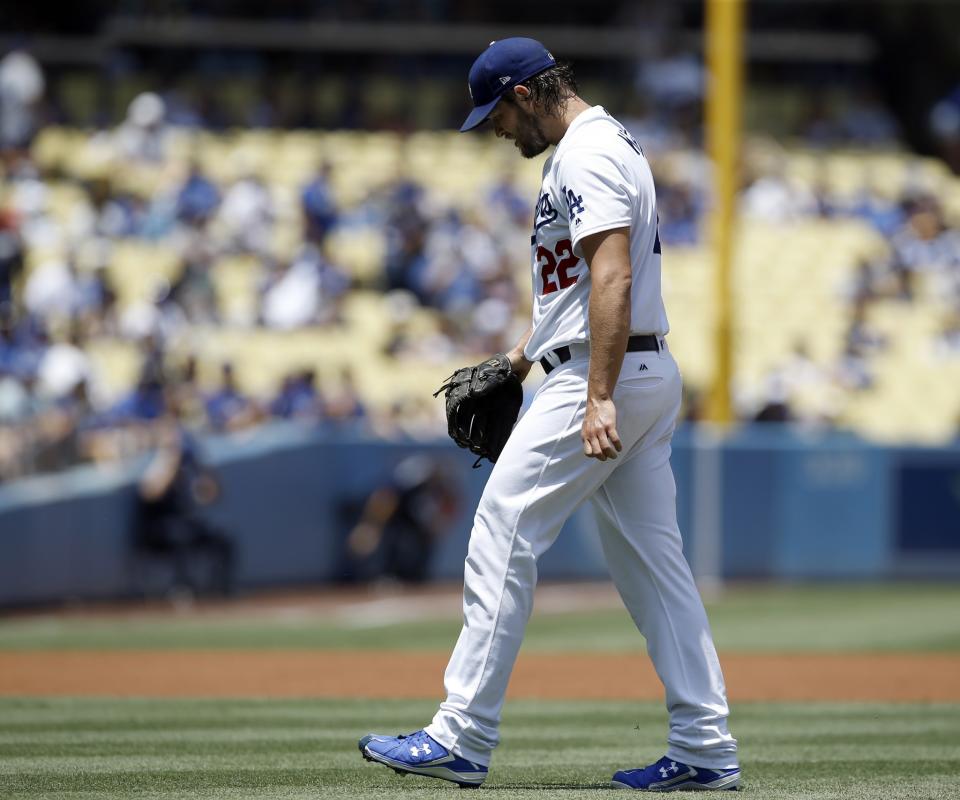The Dodgers won’t make a panicky trade, even if Clayton Kershaw's back issues linger
Anyone who believes the Los Angeles Dodgers are about to make a panicky trade because Clayton Kershaw’s back seized up Sunday afternoon doesn’t really understand why the Dodgers are the unstoppable force they are. They’ve built this machine methodically. Their organizational depth reaches down like the Mariana Trench specifically because they abhor alarmism. Other teams might care about maintaining a winning percentage near .700. The Dodgers care about today … and tomorrow … and the rest of the championships they plan on winning.
If they wanted, the Dodgers could go out and get just about anybody they want. They could take on Justin Verlander and the $56 million he is owed the next two seasons, but that would more or less torpedo any possibility of them dipping beneath the luxury-tax threshold in 2019, which may be a pipe dream already but is possible because their pipeline is so stocked with top-notch prospects. They could use any number of those prospects – Walker Buehler or Alex Verdugo or Yadier Alvarez or Mitch White or Willie Calhoun or Keibert Ruiz or Yusniel Diaz or a dozen others, because the list really is that deep – and get just about anyone.

Certainly there comes a point at which going for it, so to speak, becomes an imperative, and, yes, franchises can wait too long and watch their window close quicker than when a rainstorm approaches. The probability of this happening to the Dodgers at this juncture is minuscule. There is too much good at all levels of the organization to believe this is a go-for-it moment.
All of this is written without knowing whether the diagnosis that …
1. Clayton Kershaw will miss four to six weeks is on point. Back injuries can be terribly finicky. That’s sort of the point, though: Even if Kershaw does miss an extended period of time, the Dodgers may well be able to workshop their way around his absence without having to sacrifice a significant piece of their farm.
Kershaw, he of the 2.04 ERA and 168-to-24 strikeout-to-walk ratio and 15-2 record, still the best-pitcher-in-the-world belt-holder, did not indicate how this injury compared to the one that shelved him for 13 starts last season. The dread in Los Angeles went from our-baseball-team-is-so-good-I-don’t-even-care-we-can’t-see-them-on-TV to TEH SEEZIN IZ OVER in record time after Kershaw left Sunday’s start. There is no more nauseating pair of words to a Dodgers fan than “Kershaw” and “back.”
So, yes, the instantaneous thought was, OK, how much is …
2. Yu Darvish going to cost. And, sure, it’s possible that the Dodgers could deal for the Texas Rangers ace if the price is right. In an odd way, though, Darvish made a lot more sense for the Dodgers before the Kershaw injury than he does if Kershaw is out for a significant period of time.
A juggernaut like The Dodgers With Kershaw was almost begging to be added to. If they had any weakness – and it’s hard to argue a team that’s 68-31 has any demonstrable ones – it was the reliability of their starting pitching. Neither Alex Wood, Rich Hill nor Brandon McCarthy comes with any particular track record of consistent excellence, and though that is not a necessity for October success, it is desirable. Dropping Darvish between Kershaw and Wood would’ve been like trading for the baseball version of Best Supporting Actor. He’s the perfect complement.
This is not to say Darvish can’t be a lead man. It’s more about The Dodgers Without Kershaw. They are a very good team, maybe good enough to win the whole thing, but considering what the cost of Darvish will be if the Rangers do decide to trade him (high) and the impact he adds (less and less in a postseason environment managers are continually bifurcating more toward relievers), going after him as a savior rather than a complement doesn’t quite dovetail with that forward-thinking ethos the Dodgers employ.
After sweeping Tampa Bay over the weekend, the Rangers moved within two games of .500 – and 2½ games back of the second wild card. The American League is a giant hoard of mediocrity, with nine teams within five games of one another, and even the Oakland A’s are only 6½ back as they try to coax the best offer they can for …
3. Sonny Gray out of contenders and non-contenders alike. And of all the teams that could use a solid starter with two more years of control beyond this season – there are 29 of those – the one that makes the most sense for Gray is the New York Yankees.
And it’s not just because of Gray himself. His value is obvious. He is healthy. He is dealing. He is 27 years old and cheap – the Yankees want to get under that luxury-tax threshold, too – and, best of all, helps this year and beyond. For a team losing Michael Pineda and CC Sabathia, with a mediocre free-agent pitching class awaiting them, Gray checks a number of boxes.

Here’s the beyond-Gray part: The Garrett Cooper experiment was perfectly reasonable, but the Yankees’ lineup gets downright scary with Yonder Alonso in the middle. True, Alonso’s June and July haven’t been anything close to his May, but the prospect of him slotting into the No. 5 hole of this lineup is – well, just take a look:
Brett Gardner 7
Aaron Hicks 8
Aaron Judge 9
Matt Holliday DH
Yonder Alonso 3
Gary Sanchez 2
Starlin Castro 4
Didi Gregorius 6
Todd Frazier 5
Yes, that’s Frazier, he of the 40 home runs a season ago, hitting ninth – and that’s with Clint Frazier and Jacoby Ellsbury both on the bench. With a bullpen of Aroldis Chapman, Dellin Betances, Tommy Kahnle, David Robertson, Adam Warren and Chad Green plus that lineup, a rotation of Luis Severino, Gray, Sabathia and Jordan Montgomery or Masahiro Tanaka is serviceable enough. That’s a team that can maintain the first wild-card spot it holds today. And it may be the only team in the AL that can hit with the Astros.
It’s why Houston, at least in theory, has prioritized pitching, and why …
4. Jacob deGrom’s name has come up in connection with the Astros. Let it be said here: The New York Mets aren’t trading deGrom. And they shouldn’t.
It’s easy to get caught up in now, and right now the Mets are themselves minus the T, plus an S. This is not who they’re going to be, though, and anyone urging them to trade deGrom seems to look past this.
Remember, the Mets came into this season on the heels of consecutive playoff appearances for the first time since 1999-2000, and they were expected to contend again. Their pitching absolutely imploded, starting with Noah Syndergaard’s nearly season-long injury, continuing with injury and/or ineffectiveness from Matt Harvey, Zack Wheeler, Robert Gsellman, Seth Lugo and Steven Matz. It was a parade of ineffectuality.
The only good part has been deGrom, with his blistering fastball and 144 strikeouts in 125 2/3 innings reminding the Mets that promise remains. While the danger of building around pitching is presuming health, consider the Mets’ premise for keeping the team together: With Syndergaard and deGrom, they have two legitimate No. 1-quality starting pitchers whom they’ll pay next to nothing. Michael Conforto is a star. Yoenis Cespedes, when he’s healthy, is the same. And Amed Rosario, the shortstop we’ll see in the big leagues soon enough, could be a third, and quick. That is the type of a core around which a team builds rather than rebuilds.
And that’s why so rarely do players like deGrom get moved. It’s typically the …
5. Marco Estradas of the world on whom teams can agree to a deal, because both the buyer and seller value middle-of-the-road rental players pretty similarly. The Blue Jays aren’t going to ask for a king’s ransom for Estrada because pitchers with 5.52 ERAs aren’t exactly screaming to be traded for. And teams targeting him understand there’s enough to like about Estrada – the pumped-up strikeout rate, the fielding-independent numbers that look a lot like his successful years past – to value him slightly better than a guy who has gotten lit up as often as he has.
It’s really quite staggering to see what hitters are doing to Estrada this season. For years, he cultivated a reputation as a guy who is impossible to square up. In 2015, batters hit .203/.269/.364 against Estrada. Last year, it was .203/.278/.361. This season, it’s like Estrada is pitching to a lineup full of Robinson Canos: .271/.340/.492.
Maybe it takes Toronto kicking in some cash. Perhaps it just asks for a non-prospect and salary relief. Whatever the case, Estrada, who entered this season with $40 million-plus awaiting him in free agency, now is pitching for anything beyond a cheap, one-year, make-good deal. It’s a troubling fall, seeing as he’s now behind …
6. Jaime Garcia when it came to rental pitchers until the Atlanta Braves dealt him and catcher Anthony Recker to the Minnesota Twins for pitching prospect Huascar Ynoa. It came after a previous incarnation of the trade had stalled and left the Braves dangling Garcia to other teams in hopes his last few starts had drummed up a bigger market.
(Can we pretty please, with sugar on top, Winston Wolf-style, stop the ridiculous assertions, suppositions and theories that a single start, or two starts, or, in the case of a position player, a few games, makes a damn bit of difference when it comes to a player’s trade value? It doesn’t. It doesn’t. It doesn’t. It never did. It never will. It doesn’t. OK? Thank you.)
Anyway, Jaime Garcia is the same middle-of-the-road starter he’s been for a couple years now. He generates a ton of groundballs, which, actually, might have suited him well for teams with great infield defense like the Angels, Dodgers and even Royals, who made their own deal Monday afternoon, acquiring starter Trevor Cahill and relievers Ryan Buchter and Brandon Maurer for left-hander Matt Strahm, prospect Esteury Ruiz and pitcher Travis Wood. Garcia’s profile does not fit all that well with the Twins. They went for him anyway, and the Royals got Cahill, leaving …
7. Lance Lynn in limbo. Lynn’s potential availability shows why teams tend to hang on until the end of July to make a deal instead of trying to jump the market. Kansas City is deep into the pitching rental market – something that looked foolish a week ago, when they had lost six of seven and were two games under .500.
Now, after a fat-and-happy five games against Detroit and Chicago, the Royals are in a tie for the second wild-card spot with Tampa Bay. A rental starter to put a merciful end to Travis Wood’s spell in the rotation seems a necessity. The Royals’ decision to hold onto what they had was cemented when they clawed back to .500. Getting a Lynn or a Garcia or someone of that ilk seems the prudent move.

Thing is, the Cardinals are not in an altogether different position than the Royals. They’re just 4½ games back of their division lead, and though they’ve spent the season as a continuous disappointment, every week offers new proof of a team once thought dead or out of it that gets defibrillated by the sport’s general mediocrity. Baseball in 2017: Pretty much everyone sucks enough that you might not!
Lynn is the pitcher every number cruncher is just waiting to regress. He gives up a ton of home runs and walks too many. His average on balls in play is .225 – nearly 75 points below his career. He’s stranding runners at a career-high rate. Pretty much everything that has gone well for Lynn has. He is one of the only bright spots for a Cardinals team trying to find its identity – searching so hard that even with Dexter Fowler and Stephen Piscotty and Randal Grichuk and Tommy Pham and Magneuris Sierra and Jose Martinez and the just-traded-for Tyler O’Neill in the outfield, they still at least inquired about …
8. Giancarlo Stanton in a potential trade. It never went anywhere. It can’t, because the Marlins, whose last 15 years have been spent in ownership hell, are getting one last delightful parting gift from Jeffrey Loria, who hasn’t done enough damage already.
While trading Stanton at this juncture may be an impossibility – few teams could stomach the 10 years and $295 million remaining on his deal, and those that could probably have better places to spend them come the winter of 2018 – at the very least allowing the Marlins’ baseball-operations people to explore the possibility would, you know, empower them with the ability to do their jobs and leave the franchise in better shape going forward.
No. That would be the right thing to do when Loria and his consigliere, David Samson, have made careers in baseball of just the opposite. Samson, in fact, has been trying to ingratiate himself into the potential new ownership groups, as FanRag’s Jon Heyman reported, and Derek Jeter’s supposed capitulation to the idea might be his worst miscalculation since, well, this.
There’s really no compelling argument for a franchise with awful local revenue to carry a $30 million-a-year player on its roster, and that’s what Stanton will be to the Marlins: an anchor. So they should be exploring a deal for him now, as he’s hitting .271/.356/.578 with 30 home runs, if only to get a better sense of who may want him this offseason and what such a trade may bring. This is the time of year to test the waters, and it’s why even if …
9. Rafael Devers is just 20 years old and the Red Sox are in the midst of a tight race for the AL East crown, calling him up now is the proper move. This does not marry them to using him for the rest of the season. If Devers proves capable of hitting major league pitching as well as he has minor leaguers – he’s slashing .311/.377/.578 between Double-A and Triple-A this season – then he’s the solution they’ve long sought.
Unlike Yoan Moncada last season, Devers doesn’t have a whole lot of swing-and-miss in his bat. Two years ago, a well-respected scout said Devers was the closest thing to Robinson Cano he’d seen since Cano’s debut, and while Devers’ body may move him off third base and to who-knows-where sooner than later, that bat plays anywhere.
It’s not going to bring some Cody Bellinger-type thunder. Actually, it complements quite well the things the Red Sox do better than most: score runs despite being the only AL team still with double-digit homers this season. And if, over the next week, he’s a bit meh, there’s plenty of third-base options on the trade market. That’s the reality of the …
10. Clayton Kershaw mess in Los Angeles. It looks grim. It looks troublesome. But better it happen July 23 than July 30.
Back injuries are fickle creatures, of course, and if this ends up anything like last year, the Dodgers would need to prepare themselves for the rest of the season without Kershaw. He didn’t make a start between June 26 and Sept. 9 last season – and those last three weeks of September were vital to rebuilding his arm strength after going 38-24 without him. October is no time to ramp up, and with the injury coming a month later this year, the Dodgers would be advised to heed caution.

Then again, this is Kershaw. He wants to pitch. He demands to pitch. Even if his playoff history not living up to his regular-season mastery is far from his sole motivator, the world deserves to see playoff Kershaw every bit as good as the 34-starts-a-year version.
The Dodgers are winning the National League West this year. Even without Kershaw, it’s almost a foregone conclusion. They’ve got Bellinger and Corey Seager and Justin Turner and a scary lineup and enough depth up and down the roster that it would take a miracle. In those playoff games, though, those short series, the best team in baseball, a 100-something-win ogre, can get swept right out. And as much as fans may want to preserve the delight of this season, to put trust in The Dodgers Without Kershaw, that’s a tough sell to an organization that has spent years building itself around that idea that no one person, no one move, will make or break a team, and as good as this one is, it may no longer be good enough to ignore that guiding principle.
More MLB coverage on Yahoo Sports:

